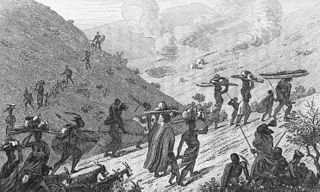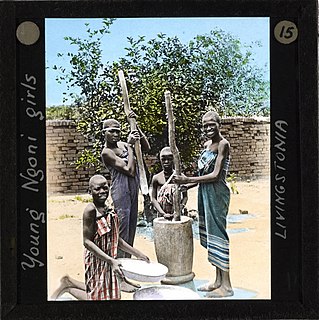The Qwabe Kingdom (Zulu : amaQwabe) is the senior branch of the House of Malandela, the royal pre-Zulu family, descendant from Qwabe (1575) the son of Malandela or Mayandeya. [1]
The Qwabe Kingdom (Zulu : amaQwabe) is the senior branch of the House of Malandela, the royal pre-Zulu family, descendant from Qwabe (1575) the son of Malandela or Mayandeya. [1]
The amaQwabe are the senior and larger clan of the Makhanya and the Zulu clans all descending from one common ancestor, Malandela. [2] They are descendant from Qwabe (whose name means a Large 'musical bow' [3] ) the eldest son of Malandela and his wife Nozidiya/Nozinja of the Zungu clan. [4] Following the death of Malandela, Qwabe became the king. [1] In accordance with Nguni customary practices when Qwabe inherited the kingship, he went and built a new homestead to serve as the center of the kingdom, leaving his younger brother Zulu to rule over a few people who remained at their father Malandela's estate. [5]
The kingdom thrived sometime in the 18th century as "one of the most ancient and famous tribes in Natal and Zululand". [2] At its peak the amaQwabe occupied central KwaZulu-Natal, they were found beneath the Amandawe and Ngoye Hills, south of the Mhlathuze River until it reached the Mthethwa and Dube areas, up the Mhlathuze River almost as far as Nkandla forest, winding up between the Mhlathuze and Tugela Rivers and finally overflowing into Natal. [2]
After separating from his brethren with the majority of Malandela's people, Qwabe and his followers settled beneath the Ngoye hills. This is where Qwabe built the kingdoms new center, eMthandeni. Before amaQwabe occupation the area between the Mhlathuze and Tugela rivers was occupied by the Cele clan a sub-branch of the Mthethwa kingdom. The Qwabe drove out the Thuli and Cele clans as well as the amaMbili, amaKwela and amaKomo tribes, from between the Mhlathuze and the Tugela rivers into the coast district of Natal. [5] Before the Shaka era the amaQwabe kingdom had already expanded control over parts of Natal south of the Thukela River. The expansion of this kingdom over territory and smaller chiefdom's was enough to regard it as one of the few larger kingdoms of the region.
The kingdom under Phakatwayo kaKhondlo and generally was characterized by seven large villages, each headed by an important member from the ruling lineage. Regiments were round up by village rather than age, this included women regiments also. Evidence suggest that the authority to form women regiments (isigodlo) was only given to senior powerful kings such as Phakatwayo of The Qwabe, Dingiswayo of the Mthetwa and
Zwide of the Ndwandwe for instance. [1]
| Qwabe Royal House Gumede | |
|---|---|
| Parent family | Nguni |
| Country | South Africa |
| Founder | Qwabe kaMalandela |
| Current head | Makhosini Wellington Qwabe |
| Connected families | |
| Cadet branches | |

Shaka kaSenzangakhona, also known as Shaka Zulu and Sigidi kaSenzangakhona, was the king of the Zulu Kingdom from 1816 to 1828. One of the most influential monarchs of the Zulu, he ordered wide-reaching reforms that reorganized the military into a formidable force.

Zulu people are a native people of Southern Africa of the Nguni. The Zulu people are the largest ethnic group and nation in South Africa, with an estimated 14.39 million people, in total of which 13.78 million people live in South Africa, mainly in the province of KwaZulu-Natal.

KwaZulu-Natal is a province of South Africa that was created in 1994 when the government merged the Zulu bantustan of KwaZulu and Natal Province.

The Mfecane, also known by the Sesotho names Difaqane or Lifaqane, was a historical period of heightened military conflict and migration associated with state formation and expansion in Southern Africa. The exact range of dates that comprise the Mfecane varies between sources. At its broadest, the period lasted from the late eighteenth century to the mid-nineteenth century, but scholars often focus on an intensive period from the 1810s to the 1840s.
Dingiswayo was a Mthethwa king, well known for his mentorship over a young Zulu general, Shaka kaSenzangakhona, who rose to become the greatest of the Zulu Kings. His father was the Mthethwa King, Jobe kaKayi. It was under King Dingiswayo that the Mthethwa rose to prominence, mostly employing diplomacy and assimilation of nearby chiefdoms to strengthen his power base. According to Mthethwa (1995), the Mthethwas are descended from the Nguni peoples of northern Natal and the Lubombo Mountains, whose modern identity dates back some 700 years.

The Battle of Gqokli Hill has been claimed by some to have occurred on or around April 1818, a part of the Ndwandwe-Zulu War between Shaka of the Zulu nation and Zwide of the Ndwandwe just south of present-day Ulundi. However, some claim that the battle never actually happened.

Nongoma is a town in Zululand, KwaZulu-Natal, South Africa. It is the seat of the Nongoma Local Municipality. It is situated 300 km north of Durban and 56 km from Ulundi; it is surrounded by the Ngome Forest. It is a busy market town that serves a large surrounding area. It is assigned registration plate NND.
Zwide kaLanga was the king of the Ndwandwe (Nxumalo) nation from about 1805 to around 1820. He was the son of Langa KaXaba, a Nxumalo king.
The Northern Ndebele people are a Nguni ethnic group native to Southern Africa. Significant populations of native speakers of the Northern Ndebele language (siNdebele) are found in Zimbabwe and as amaZulu in South Africa. They differ from Southern Ndebele people who speak isiNdebele of KwaNdebele.

The Ngoni people are an ethnic group living in the present-day Southern African countries of Malawi, Mozambique, Tanzania, Zimbabwe, and Zambia. The Ngoni trace their origins to the Nguni and Zulu people of KwaZulu-Natal in South Africa. The displacement of the Nguni people in the great scattering following the Zulu wars had repercussions in social reorganization as far north as Malawi and Zambia.
Soshangana Ka Gasa Zikode, born Soshangana Nxumalo, was the Founder and the Monarch of the Gaza Empire, which at the height of its power stretched from the Limpopo river in southern Mozambique up to the Zambezi river in the north. Soshangana ruled over the Gaza state from 1825 until his death in 1858. Soshangana was also known by the name of Manukosi.

The Mthethwa Paramountcy, sometimes referred to as the Mtetwa or Mthethwa Empire, was a Southern African state that arose in the 18th century south of Delagoa Bay and inland in eastern southern Africa. "Mthethwa" means "the one who rules".

The Nguni people are a linguistic cultural group of Bantu cattle herders who migrated from central Africa into Southern Africa, made up of ethnic groups formed from iron age and proto-agrarians, with offshoots in neighboring colonially-created countries in Southern Africa. Swazi people live in both South Africa and Eswatini, while Ndebele people live in both South Africa and Zimbabwe.

The Zulu Kingdom, sometimes referred to as the Zulu Empire, was a monarchy in Southern Africa. During the 1810s, Shaka established a standing army that consolidated rival clans and built a large following which ruled a wide expanse of Southern Africa that extended along the coast of the Indian Ocean from the Tugela River in the south to the Pongola River in the north.

The Hlubi people or AmaHlubi are an AmaMbo ethnic group native to Southern Africa, with the majority of population found in Gauteng, Mpumalanga, KwaZulu-Natal and Eastern Cape provinces of South Africa.

Langalibalele (isiHlubi: meaning 'The blazing sun', also known as Mthethwa, Mdingi, was king of the amaHlubi, a Bantu tribe in what is the modern-day province of KwaZulu-Natal, South Africa.
Lubimbi people are scattered all over Africa, mostly found in Southern Africa. Notable countries being South Africa, Zimbabwe, Mozambique, Zambia, Democratic Republic of Congo, Tanzania and Uganda.
The Government of KwaZulu-Natal is the subnational government of the South African province of KwaZulu-Natal (KZN). The politics of the province take place in the framework of a constitutional monarchy and liberal multi-party parliamentary democracy within a constitutional republic whereby the King of the Zulu Nation is the ceremonial figurehead of an elected government. The provincial government comprises the second sphere of government of South Africa and consists of three branches with checks and balances between them as follows:
{{cite book}}: CS1 maint: location (link){{cite book}}: CS1 maint: location (link){{cite book}}: CS1 maint: location (link)